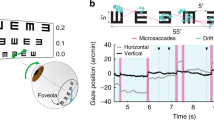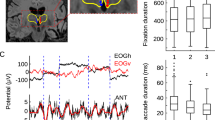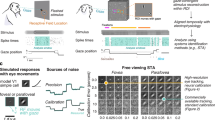Abstract
Image movements relative to the retina are essential for the visual perception of stationary objects during fixation. Here we have measured fixational eye and head movements of the turtle, and determined their effects on the activity of retinal ganglion cells by simulating the movements on the isolated retina. We show that ganglion cells respond mainly to components of periodic eye movement that have amplitudes of roughly the diameter of a photoreceptor. Drift or small head movements have little effect. Driven cells that are located along contrast borders are synchronized, which reliably signals a preceding movement. In an artificial neural network, the estimation of spatial frequencies for various square wave gratings improves when timelocked to this synchronization. This could potentially improve stimulus feature estimation by the brain.
This is a preview of subscription content, access via your institution
Access options
Subscribe to this journal
Receive 12 print issues and online access
$209.00 per year
only $17.42 per issue
Buy this article
- Purchase on Springer Link
- Instant access to full article PDF
Prices may be subject to local taxes which are calculated during checkout





Similar content being viewed by others
References
Warland, D. K., Reinagel, P. & Meister, M. Decoding visual information from a population of retinal ganglion cells. J. Neurophysiol. 78, 2336–2350 (1997).
Ferrandez, J. M., Bolea, J. A., Ammermüller, J., Normann, R. A. & Fernandez, E. A neural network approach for the analysis of multineural recordings in retinal ganglion cells. Lecture Notes Comp. Sci. 1607, 289–298 (1999).
Shoham, S. et al. The classification of spatial, chromatic, and intensity features of simple visual stimuli by a network of retinal ganglion cells. Lecture Notes Comp. Sci. 1240, 44–53 (1997).
Normann, R. A., Warren, D., Ammermüller, J., Fernandez, E. & Guillory, S. High spatio-temporal mapping of visual pathways using multi-electrode arrays. Vision Res. 41, 1261–1275 (2001).
Fernandez, E., Ferrandez, J.-M., Ammermüller, J., & Normann, R. A. Population coding in spike trains of simultaneously recorded retinal ganglion cells. Brain Res. 887, 222–229 (2000).
Meister, M. & Berry, M. J. II. The neural code of the retina. Neuron 22, 435–450 (1999).
Hartline, H. K. The responses of single optic nerve fibers of the vertebrate eye to illumination of the retina. Am. J. Physiol. 121, 400–415 (1938).
Hubel, D. & Wiesel, T. N. Receptive fields of single neurones in the cat's striate cortex. J. Physiol. (Lond.) 148, 574–591 (1959).
Riggs, L. A. & Ratliff, F. The effects of counteracting the normal movements of the eye. J. Opt. Soc. Am. 42, 872–873 (1952).
Ditchburn, R. W. & Ginsborg, B. L. Vision with a stabilized retinal image. Nature 170, 36–37 (1952).
Barlow, H. B. Eye movements during fixation. J. Physiol. (Lond.) 116, 290–306 (1952).
Steinman, R. M. & Levinson, J. Z. in Eye Movements and Their Role in Visual and Cognitive Processes (ed. Kowler, E.) 115–212 (Elsevier, Amsterdam, 1990).
Enroth-Cugell, C. & Shapley, R. M. Adaptation and dynamics of cat retinal ganglion cells. J. Physiol. (Lond.) 233, 271–309 (1973).
Kuffler, S. W. Discharge patterns and functional organization of mammalian retina. J. Neurophysiol. 16, 37–68 (1953).
Bair, W. & O'Keefe, L. P. The influence of fixational eye movements on the response of neurons in area MT of the macaque. Vis. Neurosci. 15, 779–786 (1998).
Leopold, D. A. & Logothetis, N. K. Microsaccades differentially modulate neural activity in the striate and extrastriate visual cortex. Exp. Brain Res. 123, 341–345 (1998).
Martinez-Conde, S., Machnik, S. L. & Hubel, D. H. Microsaccadic eye movements and firing of single cells in the striate cortex of macaque monkeys. Nat. Neurosci. 3, 251–258 (2000).
Gur, M., Beylin, A. & Snodderly, D. M. Response variability of neurons in primary visual cortex (V1) of alert monkeys. J. Neurosci. 17, 2914–2920 (1997).
Snodderly, D. M., Kagan, I. & Gur, M. Selective activation of visual cortex neurons by fixational eye movements: implications for neural coding. Vis. Neurosci. 18, 259–277 (2001).
Kolb, H. & Jones, J. The distinction by light and electron microscopy of two types of cone containing colorless oil droplets in the retina of the turtle. Vision Res. 27, 1445–1458 (1987).
Granda, A. M. & Fulbrook, J. E. Classification of turtle retinal ganglion cells. J. Neurophysiol. 62, 723–737 (1989).
Brivanlou, I. C. H., Warland, D. K. & Meister, M. Mechansims of concerted firing among retinal ganglion cells. Neuron 20, 527–539 (1998).
Fahle, M. Psychophysical measurement of eye drifts and tremor by dichoptic or monocular vernier acuity. Vision Res. 31, 209–222 (1991).
Eizenman, M., Hallett, P. E. & Frecker, R. C. Power spectra for ocular drift and tremor. Vision Res. 25, 1635–1640 (1985).
Coakley, D. Minute Eye Movement and Brain Stem Function (CRC Press, Boca Raton, Florida, 1983).
Shapley, R. & Victor, J. Hyperacuity in cat retinal ganglion cells. Science 231, 999–1002 (1986).
Bowling, D. B. Light responses of ganglion cells in the retina of the turtle. J. Physiol. (Lond.) 299, 173–196 (1980).
Rosenberg, A. F. & Ariel, M. Electrophysiological evidence for a direct projection of direction-sensitive retinal ganglion cells to the turtle's accessory optic system. J. Neurophysiol. 65, 1022–1033 (1991).
Berry, M. J., Warland, D. K. & Meister, M. The structure and precision of retinal spike trains. Proc. Natl Acad. Sci. USA 94, 5411–5416 (1997).
Keat, J., Reinagel, P., Reid, R. C. & Meister, M. Predicting every spike: a model for the responses of visual neurons. Neuron 30, 803–817 (2001).
Stanley, G. B., Li, F. F. & Dan, Y. Reconstruction of natural scenes from ensemble responses in the lateral geniculate nucleus. J. Neurosci. 19, 8036–8042 (1999).
Nothmore, D. P. M. & Granda, A. M. Ocular dimensions and schematic eyes of freshwater and sea turtles. Vis. Neurosci. 7, 627–635 (1991).
Jones, K. E., Campbell, P. K. & Normann, R. A. A glass/silicon composite intracortical electrode array. Ann. Biomed. Eng. 20, 423–437 (1992).
Seung, H. S. & Sompolinsky, H. Simple models for reading neuronal population codes. Proc. Natl Acad. Sci. USA 90, 10749–10753 (1993).
Rujan, P. A fast method for calculating the perceptron with maximal stability. J. Phys. (Paris) 3, 277–290 (1993).
Acknowledgements
We thank S. Massey, R.A. Normann, R. Weiler and M. Greenlee for critically reading the manuscript. This work was supported by grants from the Deutsche Forschungsgemeinschaft and the European Community (CORTIVIS) to J.A.
Author information
Authors and Affiliations
Corresponding author
Ethics declarations
Competing interests
The authors declare no competing financial interests.
Supplementary information
Rights and permissions
About this article
Cite this article
Greschner, M., Bongard, M., Rujan, P. et al. Retinal ganglion cell synchronization by fixational eye movements improves feature estimation. Nat Neurosci 5, 341–347 (2002). https://doi.org/10.1038/nn821
Received:
Accepted:
Published:
Issue Date:
DOI: https://doi.org/10.1038/nn821
This article is cited by
-
Active fixation as an efficient coding strategy for neuromorphic vision
Scientific Reports (2023)
-
Finely tuned eye movements enhance visual acuity
Nature Communications (2020)
-
A self-avoiding walk with neural delays as a model of fixational eye movements
Scientific Reports (2017)
-
Microsaccades enable efficient synchrony-based coding in the retina: a simulation study
Scientific Reports (2016)
-
High speed coding for velocity by archerfish retinal ganglion cells
BMC Neuroscience (2012)



